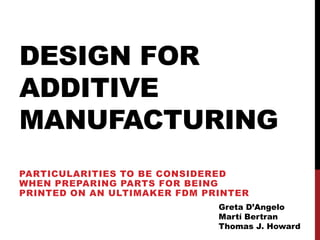
Design for ultimaker rev2
- 1. DESIGN FOR ADDITIVE MANUFACTURING PARTICULARITIES TO BE CONSIDERED WHEN PREPARING PARTS FOR BEING PRINTED ON AN ULTIMAKER FDM PRINTER Greta D’Angelo Martí Bertran Thomas J. Howard
- 2. AGENDA 1. Introduction on FDM and AM 2. Geometrical constraints 3. Support structures • Avoiding support structures • Working with support structures 4. Hollowed parts and infill 5. Printing text 6. Designing mechanisms 2
- 3. FUSED DEPOSITION MODELLING • Additive Manufacturing (AM) technologies build parts by overlapping layers of material • Extrusion of melted material through a nozzle on a build plate • Cartesian coordinates • Tolerance (in vertical direction) is determined by the diameter of the nozzle • Examples: Stratasys, RepRap, Ultimake r 3
- 4. WORKFLOW 1 2 3 Design a part Export to STL Check STL • CAD program • All packages can • Netfabb do it 6 5 4 Start printing! Upload Gcode Slice and • Ultimaker’s to printer generate Gcode controller • SD card • Cura 4
- 5. MATERIAL PROPERTIES • Ultimaker uses 3mm PLA PLA filament Polymer • Biodegradable Physical property thermoplastic Specific Gravity [g/cm3] 1,25 Melt Index [g/10min] • Highly anisotropic (190º/2,16kg) 4-8 mechanical properties • Several colors available 5
- 6. GEOMETRICAL CONSTRAINTS Minimum Wall thickness: • Vertical and tilted walls: • 2mm and above. Recommended • Horizontal walls: • 1mm and above is correct Definition 0,5mm minimum details noticed Accuracy 0,3% (min +/-0,3mm) Avoid warping Large horizontal and thick surfaces are likely to warp, skip using them if you can. Overall maximum dimensions 150*150*150 mm (x*y*z) 6
- 7. FACING GEOMETRICAL CONSTRAINTS • Scale parts • After scaling check that your part meets the geometrical constraints • Notice that wall thicknesses will be scaled down as well, and may not meet the requirements 7
- 8. SUPPORT STRUCTURES • Support structures are features added below part areas where there’s nothing • They prevent layers to collapse during it’s build up and allow part manufacturability 8
- 9. AVOIDING SUPPORT STRUCTURES: PART ORIENTATION • Part orientation is a key factor to achieve a good print • In many cases we can avoid or at least reduce the amount of supports required • Resolution is better in the z-axis faces (vertical) than XY (horizontal) stepping • Mechanical properties are better in the XY plane 9
- 10. PART ORIENTATION Smooth surfaces Staircase effect 10
- 11. AVOIDING SUPPORT STRUCTURES: SPLITTING PARTS • Splitting parts is a good way to avoid using supports • Can be done after exporting the CAD to STL by using Netfabb • To use in extreme causes because: • We’ll have to glue all the parts after the print • Tolerances will not be the same • We’ll see partition lines in our part 11
- 12. AVOIDING SUPPORT STRUCTURES: MODIFY OVERHANGING SURFACE • The printer is able to print overhanging surfaces without support structures from a minimum angle α (>30º) • We must do the modifications before exporting the STL file • Small projections from the walls (<1mm) can be printed without problems 12
- 13. AVOIDING SUPPORT STRUCTURES: MODIFY OVERHANGING SURFACE • Cura Software shows which surfaces needs support structures (<30º) Support structures required here 13
- 14. AVOIDING SUPPORT STRUCTURES: BRIDGES • The printer is able to Bridge print flat surfaces without supports between two walls • Max distance between walls: 20mm 14
- 15. AVOIDING SUPPORT STRUCTURES: BRIDGES Small holes doesn’t require changes Bridge Modified hole 15
- 16. WORKING WITH SUPPORT STRUCTURES • Accessibility: We must be able to remove SS easily • Scaring: Avoid using them in part characteristic surfaces SS can damage the finishing of these surfaces and also the tolerances • Avoid using SS below thin walls or slender and fragile parts, they can break easily while removing them 16
- 17. HOLLOWED PARTS AND INFILL • Hollow can be achieved when gcode is generated, by changing parameters of Cura • We can also choose how much infill (%) we want inside the part, by default we use between 30% and 40% • Design Tip: design always solid parts Infill Perimeters Gcode Cura View 17
- 18. HOLLOWED PARTS AND INFILL By reducing the infill: • Build time decreases • Used material decreases • It helps to avoid warping • Strength doesn’t decreases that much 18
- 19. PRINTING TEXT • Text in vertical faces will be more visible and accurate • If it’s not possible, the text at the bottom of the part (the face that sticks to the building platform), must be engraved. • In the top face of the part, text can be either engraved/embossed • It should be at least 0,8mm high and 0,8mm wide to be visible. 19
- 20. PRINTING TEXT Vertical embossed text Horizontal engraved text Vertical engraved text 20
- 21. DESIGNING MECHANISMS Joints clearance: • Design adjustments with a gap of more than 0,3mm between mobile parts 21
- 22. DESIGNING MECHANISMS Part orientation • Try to print the areas of parts that has to fit each other in the same orientation (different orientations could have different deviations/tolerances) Integrated nut holders embossed is better than engraved! 22
- 23. QUESTIONS? 23
